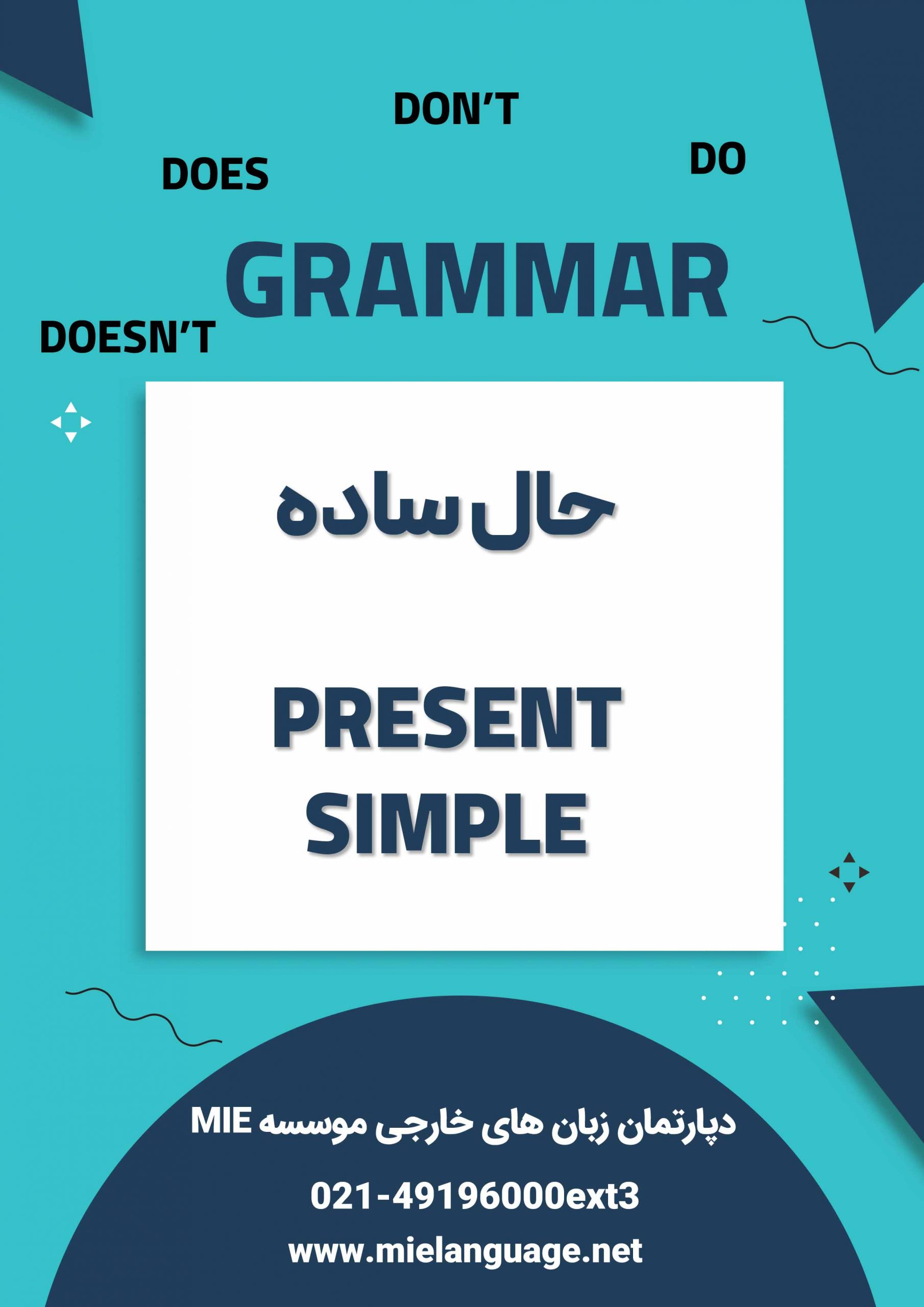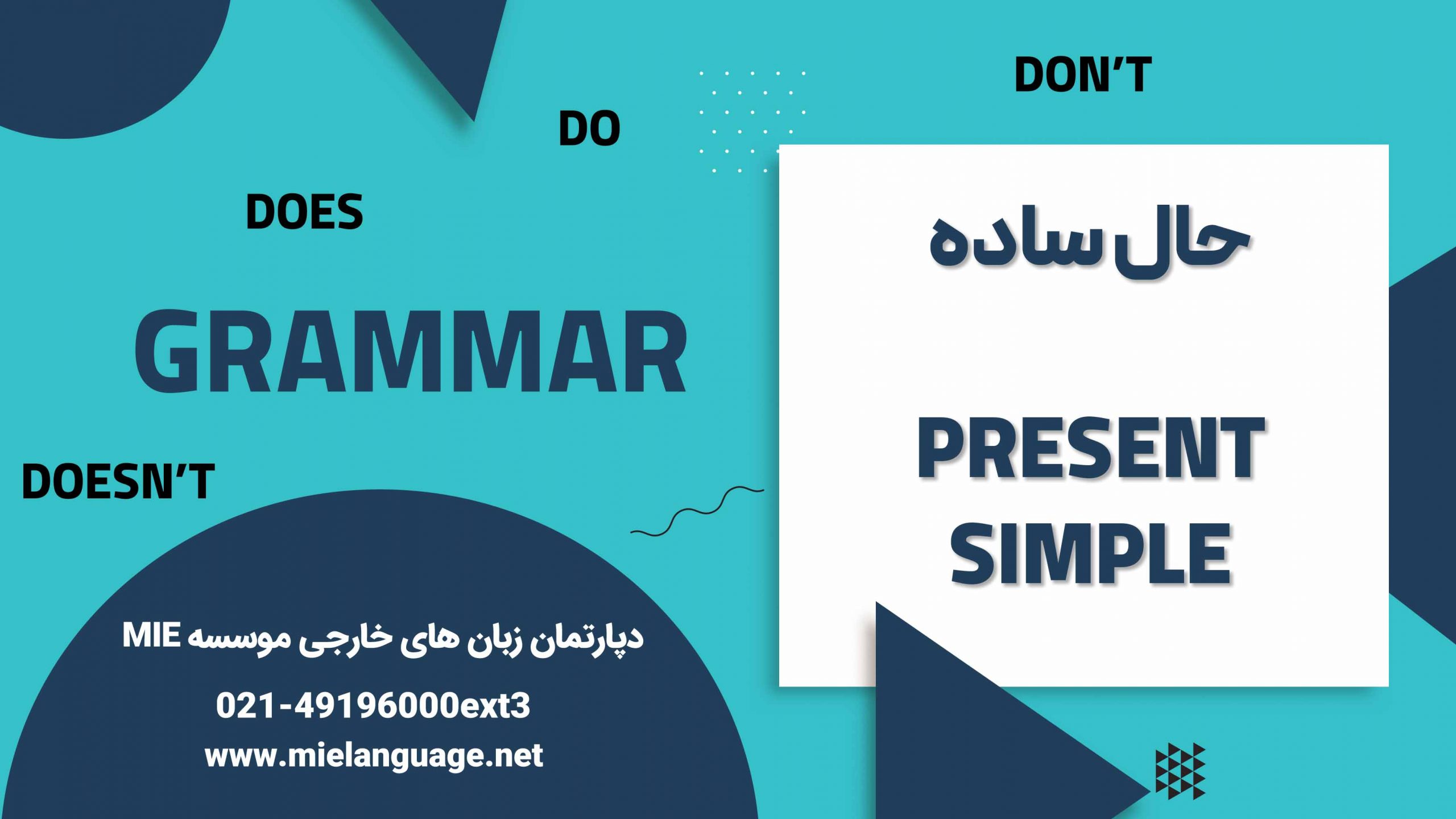حال ساده ( PRESENT SIMPLE )
حال ساده ( PRESENT SIMPLE ) از پرکاربردترین و در عین حال ساده ترین مباحث گرامری زبان انگلیسی به شمار می آید و به همین دلیل است که Simple present tense یکی از مباحث گرامری است که در سطوح ابتدایی و پایه ای تر زبان انگلیسی تدریس می شود اما ممکن است به دلیل نبودن وقت کافی، نکات مهم زمان حال ساده به زبان آموزان به طور کامل آموزش داده نشود و یا در چندین جلسه آموزشی، به آن ها پرداخته شود. به همین دلیل، ما در دپارتمان آموزش زبان انگلیسی MIE این مقاله را در رابطه با Simple present چیست، فرمول حال ساده در انگلیسی، سوال و جواب حال ساده انگلیسی، نشانه های زمان حال ساده در انگلیسی و معنی simple present برای شما عزیزان آماده کردیم تا تمامی این مطالب را همراه با 20 جمله انگلیسی حال ساده با معنی بیاموزید و پایه زبان انگلیسی خود را تقویت کرده و با دانش کافی در زمینه حال ساده ( PRESENT SIMPLE ) به سطوح بالاتر زبان انگلیسی برسید و همچنین با تماس تلفنی با ما و یا در بخش نظرات پایان این مقاله، جواب سؤالات خود را در زمینه Simple present tense به صورت رایگان دریافت کنید.

فایل تصویری موسسه ملک پور در باب معرفی پکیج انگلیسی
- دانلود
- 30 ثانیه
- 1327 K
simple present چیست و انواع جملات simple present
simple present چیست ؟ قبل از هر چیز، باید کاربرد ها و معنی simple present را به خوبی بشناسید تا بتوانید در جای مناسب از حال ساده ( PRESENT SIMPLE ) استفاده کنید و یا اگر در جمله ای Simple present tense را مشاهده کردید یا شنیدید، بتوانید کاربرد و معنی simple present را به خوبی متوجه شوید و برای این کار، باید به صورت کامل، تمامی کاربردهای آن را بشناسید؛ لطفاً به توضیحات و دسته بندی های زیر که همراه با بیش از 20 جمله انگلیسی حال ساده با معنی در اختیار شما عزیزان قرار گرفته است، ( برای کسب اطلاعات بیشتر کلیک کنید) توجه کنید:
1. از حال ساده ( PRESENT SIMPLE ) برای بیان واقعیتی کلی که هم می تواند به صورت یک حقیقت علمی و مشخص باشد و هم به صورت یک عادت شخصی که به صورت روزانه، ماهیانه، هفتگی و غیره تکرار می شود و طی مدت طولانی ثابت مانده است، استفاده کنید؛ البته باید توجه داشته باشید که برای بیان عادات، بهتر است از قید تکرار در جملات استفاده کنید تا زمان این گونه جملات نیز مشخص شود:
| معنی simple present | Simple present tense |
| دولفین ها می توانند در خشکی زندگی کنند و نفس بکشند. | .Dolphins can live and breathe in land |
| من هر روز صبح چای می نوشم. | .I drink tea every morning |
| او ساعت 8 صبح با اتوبوس به مدرسه می رود. | .She goes to school by bus at 8 a.m |
| بسکتبال بازان حرفه ای حداقل ماهیانه 1 ملیون دلار درآمد دارند. | Professional basketball players make at least one million dollars a month |
2. از حال ساده ( PRESENT SIMPLE ) همچنین برای بیان شرایطی دائمی و همیشگی و یا شرایطی که، تا آن جا که ما می دانیم، قرار نیست در آینده تغییر کند، استفاده می کنیم و با استفاده از معنی simple present می توانیم این معنی و مفهوم را به مخاطبین خود برسانیم و اگر هم کسی از جملاتی مانند مثال زیر، استفاده کرد، چنین مفهومی را متوجه می شویم:
| معنی simple present | Simple present tense |
| من در ایران زندگی می کنم. | .I live in Iran |
| او یک ماشین دارد. | .She has a car |
| آن ها در این شرکت کار می کنند. | .They work for this company |
3. برای توضیح در مورد حالت چیزی و یا برای بیان وضعیتی در حالت های مختلف از حال ساده ( PRESENT SIMPLE ) استفاده می کنیم که در اصل داری 4 بخش اصلی است؛ اولین بخش برای بیان تفکرات شخصی کسی است که معمولاً با کلماتی از قبیل know, believe و غیره بیان می شود، در دومین بخش، از حال ساده برای بیان مالکیت با همان possession استفاده می شود و معمولاً با کلماتی مانند own, contain و غیره بیان می شود، سومین بخش از این دسته، برای بیان احساسات به کار می رود که از کلماتی مانند hate, love و غیره استفاده می کنند و در آخر، از حال ساده برای صحبت در رابطه با یکی از حواس شخص مانند smell, taste و غیره استفاده می کنند؛ برای روشن شدن این مبحث، به جدول زیر توجه کنید:
| معنی simple present | Simple present tense | دسته بندی |
| من آدرس را بلد هستم. | .I know the address | Thoughts |
| او به خداوند اعتقاد دارد. | .She believes in Allah | |
| من مالک آپارتمان هستم. | .I own two apartments | Possession |
| این جعبه 20 بتری آب را در خود جا می دهد. | .This box contains 20 water bottles | |
| من بوی گاز را حس می کنم. | .I smell gas | Senses |
| او نوری را می بیند. | .She sees a light | |
| ما از غذا های تند متنفریم. | .We hate spicy food | Emotions |
| او عاشق رقصیدن است. | .He loves dancing |
4. از Simple present tense برای بیان برنامه های از پیش مشخص شده روی جدول برنامه ریزی مانند برنامه کلاسی، جلسات و یا برنامه های حمل و نقل استفاده می شود و شما عزیزان هم باید از حال ساده ( PRESENT SIMPLE ) برای بیان این گونه جملات استفده کنید؛ به مثال های زیر توجه کنید:
| معنی simple present | Simple present tense |
| کلاسم ساعت 10 صبح شروع می شود. | .My class starts as 10 a.m |
| اتوبوس نیم ساعت دیگر حرکت می کند. | .The bus leaves in half an hour |

5. کاربرد بعدی حال ساده ( PRESENT SIMPLE )برای بیان یک داستان یا روایت یک داستان است؛ یعنی اگر زمانی خواستید داستانی را تعریف کنید و روایتی را انجام دهید، باید از حال ساده استفاده کنید، مثلاً:
Sarah is a student. She has many classes. She wakes up at 8 a.m. she goes to the university with her car. Her professor comes to the class at 8:30
سارا یک دانش آموز است. او کلاس های زیادی دارد. او ساعت 8 صبح از خواب بیدار می شود. او با ماشینش به دانشگاه می رود. استادش ساعت 8:30 به کلاس می آید….
6. در حالت امری نیز از حال ساده ( PRESENT SIMPLE ) استفاده می کنیم و نمی توانید از هیچ گونه ساختار های گرامری اضافی استفاده کنید و باید حتماً برای رساندن حالت دستوری و امری، از فرمول simple present استفاده کنید، مثلاً:
| Simple present tense | معنی simple present |
| .Sit down | بشین |
| .Open the door | در را باز کن |
| .Finnish your dinner | شامت را تمام کن |
7. برای نوشتن سر تیتر اخباری مانند اخبار سیاسی، ورزشی، اقتصادی و غیره هم از حال ساده ( PRESENT SIMPLE ) استفاده می کنند و زمان این اخبار هیچ اهمیتی ندارد، ممکن است برای گذشته باشد و یا اتفاقی که ممکن است در آینده رخ دهد، در هر صورت، از زمان حال ساده برای نوشتن آن ها استفاده می شود:
.The two presidents meet in the white house
دو رئیس جمهور در کاخ سفید با هم دیدار می کنند.
فرمول simple present یا فرمول حال ساده در انگلیسی ( جمله با simple present )
حالا که با پاسخ به سؤال Simple present چیست را به صورت کامل گرفتید، نوبت به بررسی شیوه ساختاری و فرمول حال ساده در انگلیسی و جمله با simple present می رسد، زیرا با فهمیدن دقیق فرمول simple present می توانید به راحتی و بدون مشکل، از این گونه جملات استفاده کنید و همچنین شکل منفی فرمول حال ساده در انگلیسی و سوال و جواب حال ساده انگلیسی در کنار نشانه های زمان حال ساده در انگلیسی در این بخش مورد بررسی قرار می گیرد. این مقاله در دپارتمان آموزش زبان انگلیسی MIE نوشته شده است و هر گونه کپی برداری بدون ذکر منبع، غیر شرعی و حرام می باشد. فرمول حال ساده در انگلیسی به این صورت است که باید ابتدا از فاعل و بعد از آن، از شکل ساده فعل استفاده کنید سپس می توانید ادامه جمله را قرار دهید اما باید توجه داشته باشید که در سوم شخص (he, she, it)، حتماً باید یک s به فعل اصلی اضافه کنید؛ اما برای سوال و جواب حال ساده انگلیسی و منفی کردن، باید از فعل کمکی does برای سوم شخص و do برای دیگر ضمایر، استفاده کنیم، لطفاً به مثال های زیر توجه کنید:
| Simple present tense | Simple present tense (negative) |
| .I go to school by bus | .I don’t go to school by bus |
| .She goes to school by bus | .She doesn’t go to school by bus |
| .He goes to school by bus | .He doesn’t go to school by bus |
| .You go to school by bus | .You don’t go to school by bus |
|
.We go to school by bus |
.We don’t go to school by bus |
| .They go to school by bus | .They don’t go to school by bus |
| Simple present tense (question) | Simple present tense (answer) |
| ?Do you go to school by bus | .Yes, I do. No, I don’t |
| ?Does she go to school by bus | .Yes, she does. No, she doesn’t |
| ?Does he go to school by bus | .Yes, he does. No, he doesn’t |
| ?Do we go to school by bus | .Yes, we do. No, we don’t |
| ?Do they go to school by bus | .Yes, they do. No, they don’t |
نکات مهم زمان حال ساده
همانطور که در مثال های جدول بالا مشاهده کردید، زمانی که از فعل کمکی does برای سوم شخص در حالت سوال و جواب حال ساده انگلیسی و منفی استفاده می کنیم، دیگر نیازی به اضافه کردن s به آخر فعل اصلی نداریم و فعل اصلی به صورت ساده می آید، این یکی از مهم ترین و اساسی ترین نکات مهم زمان حال ساده است که باید به آن توجه کنید. علاوه بر این، باید توجه داشته باشید که برخی افعال مانند have، تنها با اضافه کردن s به آخرشان، نمی توانیم آن ها را برای سوم شخص استفاده کنیم و به کلی ساختار آن ها تغییر می کند مانند has، همچنین، همانطور که در مثال های بالا مشاهده کردید و در بخش کاربرد فرمول simple present گفتیم، بهتر است از قید تکرار برای این گونه جملات استفاده کنید، البته در بیشتر کاربرد های حال ساده ( PRESENT SIMPLE ) این مفهوم خود به خود به مخاطب منتقل می شود.
مقالات مرتبط
✅ آیا تنها کاربرد حال ساده در زبان انگلیسی برای بیان عادات و اتفاقاتی است که همیشه و یا به طور متداول رخ می دهند یا کاربردها و معانی مهم دیگری نیز دارند؟
زمان حال ساده کاربردهای بسیار زیادی دارد که در این مقاله به آن ها اشاره شد و برای استفاده و فهمیدن این کاربرد ها باید حتماً به خوبی با تمامی آن ها آشنا باشید و از آن ها در مکالمات و متون خود استفاده کنید.
✅ اگر تیتر خبری که می خواهیم بنویسیم برای زمان گذشته باشد، یعنی این خبر در زمان گذشته اتفاق افتاده باشد، باید از زمان گذشته استفاده کرد؟
خیر، در هر صورت، باید برای بیان تیتر خبر های ورزشی، سیاسی، اقتصادی، اجتماعی و غیره، از زمان حال ساده در زبان انگلیسی استفاده کنید و هیچ اهمیتی ندارد که زمان این خبر برای کی است.
✅ آیا در سوم شخص و در حالت پرسشی و منفی باید به انتهای فعل اصلی s اضافه کرد، درست مثل جملات عادی و مثبت؟
خیر، باید توجه داشته باشید که در هر جمله ای که از فعل کمکی does استفاده می کنید، چه برای پرسش و پاسخ و چه برای منفی کردن، باید از فعل به صورت ساده استفاده کنید و نیازی به اضافه کردن s نیست.
✅ آیا با اضافه کردن s به انتهای تمامی افعال، می توان در حالت سوم شخص، فعل مناسبی ساخت؟
خیر، برای برخی از افعال، نمی توانید تنها با اضافه کردن s به انتهای آن ها، فعل مناسب بسازید، مانند have که در سوم شخص به has تبدیل می شود و به طور کلی شیوه نوشتن و بیان آن تغییر می کند.
سخن پایانی در رابطه با حال ساده ( PRESENT SIMPLE )
حال ساده ( PRESENT SIMPLE ) همانطور که گفتیم، یکی از پر کاربدترین و ساده ترین حالت های موجود در زبان انگلیسی است و با دانستن معنی simple present و فرمول حال ساده در انگلیسی، می توانید به راحتی، جملات فراوانی را در زبان انگلیسی به کار ببرید و حتی جملات زیادی را نیز متوجه شوید و ما با به کار بردن بیش از 20 جمله انگلیسی حال ساده با معنی و همچنین نشانه های زمان حال ساده در انگلیسی، این مبحث را برای شما عزیزان توضیح دادیم. این مقاله که در دپارتمان آموزش زبان انگلیسی MIE به صورت کامل، برای پاسخ به سؤال Simple present چیست، نوشته شده است، به صورت کامل نکات مهم زمان حال ساده را برای شما عزیزان شرح داد تا دیگر مشکلی برای یادگیری این مبحث نداشته باشید، همچنین شما می توانید برای یادگیری دیگر گرامر های زبان انگلیسی به قسمت آموزش گرامر زبان انگلیسی مراجعه نمایید و از ویدئوهای آموزشی رایگان موجود در سایت ما برای یادگیری آسان گرامرها استفاده نمایید و یا در کلاس آنلاین زبان انگلیسی موسسه MIE شرکت نمایید همچنین می توانید از طریق تماس تلفنی رایگان و یا بخش نظرات در پایان این مقاله، پاسخ به سؤالاتتان را دریافت کنید.









تنها کاربرد حال ساده در زبان انگلیسی برای بیان عادات و اتفاقاتی است که همیشه و یا به طور متداول رخ می دهند یا کاربردها و معانی مهم دیگری نیز دارند؟
زمان حال ساده کاربردهای بسیار زیادی دارد که در این مقاله به آن ها اشاره شد و برای استفاده و فهمیدن این کاربرد ها باید حتماً به خوبی با تمامی آن ها آشنا باشید و از آن ها در مکالمات و متون خود استفاده کنید.
اگر تیتر خبری که می خواهیم بنویسیم برای زمان گذشته باشد، یعنی این خبر در زمان گذشته اتفاق افتاده باشد، باید از زمان گذشته استفاده کرد؟
خیر، در هر صورت، باید برای بیان تیتر خبر های ورزشی، سیاسی، اقتصادی، اجتماعی و غیره، از زمان حال ساده در زبان انگلیسی استفاده کنید و هیچ اهمیتی ندارد که زمان این خبر برای کی است.
آیا در سوم شخص و در حالت پرسشی و منفی باید به انتهای فعل اصلی s اضافه کرد، درست مثل جملات عادی و مثبت؟
خیر، باید توجه داشته باشید که در هر جمله ای که از فعل کمکی does استفاده می کنید، چه برای پرسش و پاسخ و چه برای منفی کردن، باید از فعل به صورت ساده استفاده کنید و نیازی به اضافه کردن s نیست.
آیا با اضافه کردن s به انتهای تمامی افعال، می توان در حالت سوم شخص، فعل مناسبی ساخت؟
خیر، برای برخی از افعال، نمی توانید تنها با اضافه کردن s به انتهای آن ها، فعل مناسب بسازید، مانند have که در سوم شخص به has تبدیل می شود و به طور کلی شیوه نوشتن و بیان آن تغییر می کند.
چنتا مثال میزنید
Simple present tense:
I go to school by bus.
She goes to school by bus.
He goes to school by bus.
You go to school by bus.
We go to school by bus
Simple present tense (negative):
I don’t go to school by bus.She doesn’t go to school by bus.
He doesn’t go to school by bus.You don’t go to school by bus.
We don’t go to school by bus.
They don’t go to school by bus
Simple present tense (question)?
Do you go to school by bus?
Does she go to school by bus?
Does he go to school by bus?
Do we go to school by bus?
Do they go to school by bus